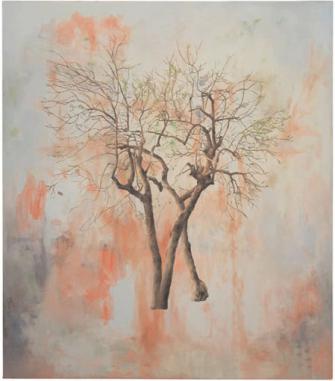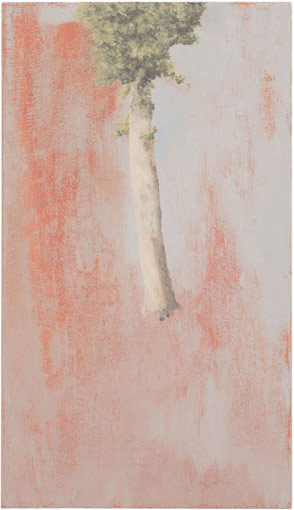How to describe these paintings? How to interpret them? Allow them to “take root in the mind of the viewer”! Imagine the room in which these small, wonderful paintings in oil and wax are lined up along the walls like trees on a boulevard. We stroll past, linger, and we look at and experience their presence. How sensitively and sensually they are painted. In terms of subjects, brushwork, color, and light, they are reminiscent of old masters and yet are anything but traditional landscape painting. Tree for tree, individually, like portraits, removed from their surroundings: without soil and without horizon. They grow out of the lower edge of the painting and fill nearly the entire canvas. They spread their branches into a plane of many grays that also include other colors: blue, violet, pink, modeled matte and velvety. In the repetition of the composition unfolds an all but inexhaustible variety of colors and forms. Slowness and care, thought and emotion are inscribed in these paintings. The pathos of the history of painting and something very contemporary merge. Their beauty, their grace and melancholy are seductive. “The brushwork, lines and contours are carefully and delicate, drawing on the sheer love for painterly tradition and accomplishment as if the brazen iconographic humor of Guston were somehow transmuted back through the strategies of Italian Renaissance,” writes Fred Dewey. Let’s accept their invitation to observe them attentively and contemplate them.
Lucas Reiner’s paintings communicate immediately through the aesthetic pleasure of painting and through their subject: the tree. We recognize it as an object in the real world and, looking and understanding, we bring in the absent: the city. Anyone who knows Los Angeles will have filled in, in his or her imagination, the “voids” of the painting. (oder besser: “projects into the un-filled-in space”?)The trees, crooked, mistreated, strangely trimmed, pruned into shape by the traffic, grazed by the truck, cut back to clear the view of the billboards, alienated by signs, Christmas decorations, or graffiti. Fragile yet tenacious, vying for space: sideways against the wall of the building, upward against the power lines. That is the story this cycle seems to tell: of the relationship of people to creation, of the domestication of nature by civilization, of survival in an urban context.



































